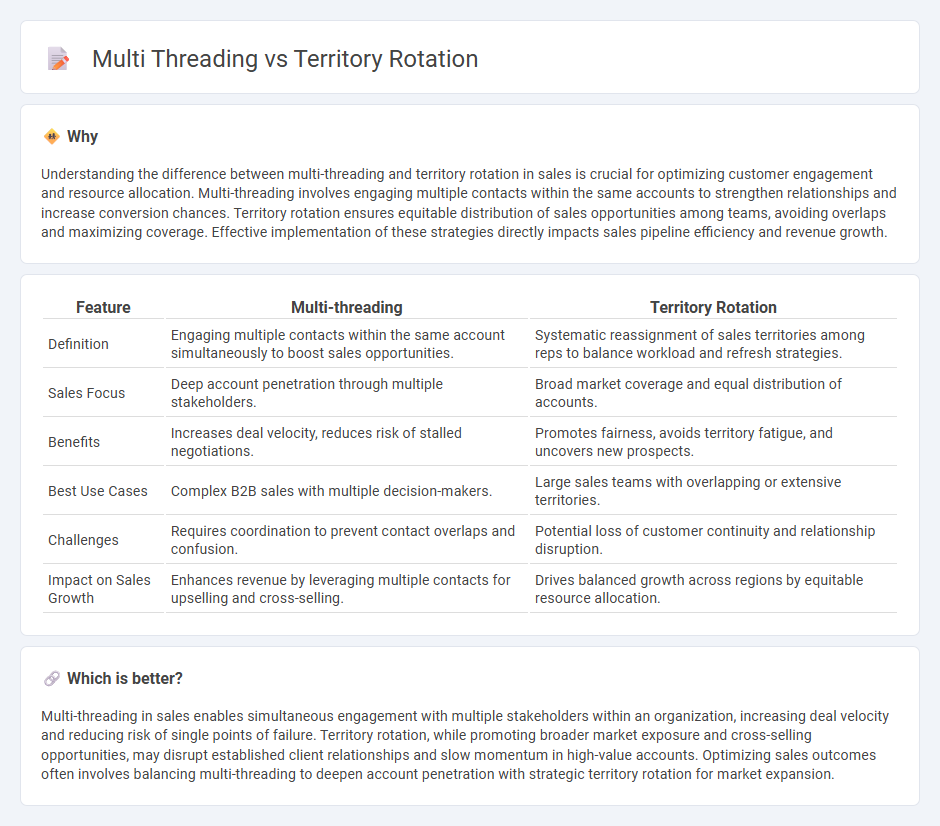
Sales teams often choose between multi-threading, where multiple contacts within a single account are engaged simultaneously, and territory rotation, which redistributes sales regions among representatives to balance workloads and optimize coverage. Multi-threading strengthens relationships and increases deal closure rates by mitigating risks of single-point failures, while territory rotation enhances fairness and market penetration by refreshing sales efforts in evolving sectors. Explore these strategies further to determine the best approach for maximizing your sales performance.
Why it is important
Understanding the difference between multi-threading and territory rotation in sales is crucial for optimizing customer engagement and resource allocation. Multi-threading involves engaging multiple contacts within the same accounts to strengthen relationships and increase conversion chances. Territory rotation ensures equitable distribution of sales opportunities among teams, avoiding overlaps and maximizing coverage. Effective implementation of these strategies directly impacts sales pipeline efficiency and revenue growth.
Comparison Table
| Feature | Multi-threading | Territory Rotation |
|---|---|---|
| Definition | Engaging multiple contacts within the same account simultaneously to boost sales opportunities. | Systematic reassignment of sales territories among reps to balance workload and refresh strategies. |
| Sales Focus | Deep account penetration through multiple stakeholders. | Broad market coverage and equal distribution of accounts. |
| Benefits | Increases deal velocity, reduces risk of stalled negotiations. | Promotes fairness, avoids territory fatigue, and uncovers new prospects. |
| Best Use Cases | Complex B2B sales with multiple decision-makers. | Large sales teams with overlapping or extensive territories. |
| Challenges | Requires coordination to prevent contact overlaps and confusion. | Potential loss of customer continuity and relationship disruption. |
| Impact on Sales Growth | Enhances revenue by leveraging multiple contacts for upselling and cross-selling. | Drives balanced growth across regions by equitable resource allocation. |
Which is better?
Multi-threading in sales enables simultaneous engagement with multiple stakeholders within an organization, increasing deal velocity and reducing risk of single points of failure. Territory rotation, while promoting broader market exposure and cross-selling opportunities, may disrupt established client relationships and slow momentum in high-value accounts. Optimizing sales outcomes often involves balancing multi-threading to deepen account penetration with strategic territory rotation for market expansion.
Connection
Sales teams enhance productivity through multithreading by engaging multiple stakeholders within a client organization simultaneously, increasing deal velocity and reducing risk. Territory rotation complements this by distributing accounts cyclically among sales representatives, ensuring fresh perspectives and equal opportunity for relationship-building. Combining multithreading with territory rotation optimizes coverage, fosters diverse client interactions, and drives balanced revenue growth.
Key Terms
Account Assignment
Territory rotation optimizes account assignment by dynamically reallocating clients to different sales reps based on territory performance and capacity, enhancing coverage and reducing overlap. Multi-threading in account assignment enables multiple internal stakeholders to engage simultaneously with a client, fostering collaboration across departments for complex sales processes. Explore how integrating territory rotation with multi-threading can maximize sales efficiency and customer engagement.
Relationship Mapping
Territory rotation enhances relationship mapping by systematically organizing and redistributing client accounts among sales teams, ensuring balanced coverage and deeper customer insights. Multi-threading strengthens relationship mapping by engaging multiple stakeholders within a client organization simultaneously, promoting collaboration and reducing dependency on a single contact. Explore how integrating territory rotation with multi-threading techniques optimizes sales strategies and customer relationship management.
Coverage Strategy
Territory rotation enhances sales coverage by systematically shifting focus across regions to maximize client engagement and market penetration, while multi-threading leverages multiple contacts within a single account to deepen relationships and drive complex sales cycles. Coverage strategy combining territory rotation ensures broad market reach, whereas multi-threading strengthens account-specific influence and decision-making efficacy. Explore how integrating these strategies can optimize your salesforce performance and customer coverage.
Source and External Links
How to do Lead Rotation in HubSpot for Territories - Territory rotation involves defining sales territories (often geographically) and using automated workflows to assign and rotate leads fairly among sales reps within those territories to optimize coverage and workload balance.
Executing a Territory Plan - RevOps Co-op Blog - Effective territory rotation can include methods like round-robin inbound lead allocation based on zip codes or named accounts, requiring sales leadership support to ensure smooth transition and quota attainment by sales teams.
Effective Sales Territory Planning: Steps and Strategies - SPOTIO - Incorporating lead rotation schedules within territory plans ensures regular follow-ups and balanced distribution of new business and account management, while tracking performance and adjusting plans quarterly enhances ongoing sales effectiveness.
 dowidth.com
dowidth.com